Retro, Zelda-inspired action RPGs with an interesting time mechanic are like buses* – you wait an age for one, and then Devolver Digital publishes two within a few weeks of each other.
*Magical, flying buses, that you summon with a kazoo. Did we mention that Fork Parker drinks?
Minit, the adventure RPG played in 60 second increments – and at the end of each minute, you die – is at one end of Devolver’s temporal roguelite spectrum. The Swords of Ditto, on the other hand, takes a much longer form: you have four days to save the world, and if you don’t save it in that time? You go around again (and again, and again) until you eventually do.
If you think that sounds quite like Majora’s Mask – where Link has just three days to save the world, before a very ominous and angry moon recreates Michael Bay’s Armageddon – you’d be right. The Swords of Ditto looks and plays like a SNES-era Zelda game, with the time-rending mechanics of the N64’s Majora’s Mask. In those terms, it sounds straight-forward, but Ditto’s core loop is even smarter than that.
One of the central tenets of the Legend of Zelda series is that while themes run throughout – the Triforce, the hero of time, the princess, Ganondorf – the universe is effectively rebooted between each game, as the hero wakes from a long, dormant slumber. As a piece of exposition, it’s sequel setting and technological advance wrapped up in a neat little bow. Yes, everything’s the-same-but-different, because several in-universe generations have passed between games.
The Swords of Ditto centres its entire being, not just its story – which in the greatest roguelite tradition is a lightweight take on the classical monomyth, deliberately unfussy, easy to both follow and loop – around this conceit. And it’s not afraid to be brutal about it.
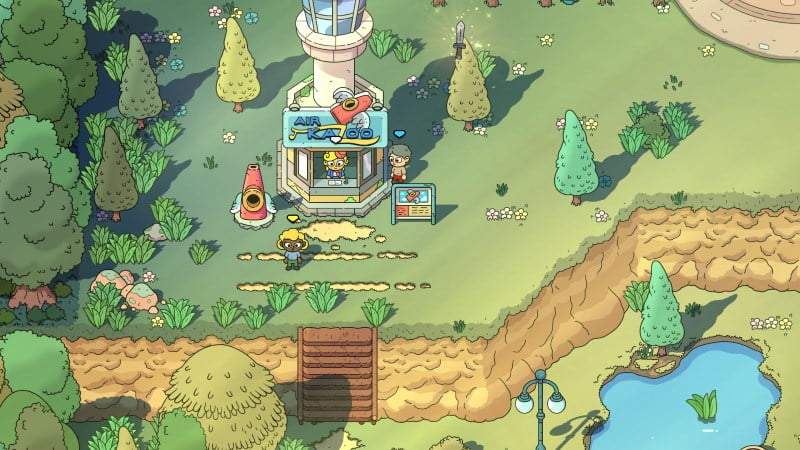

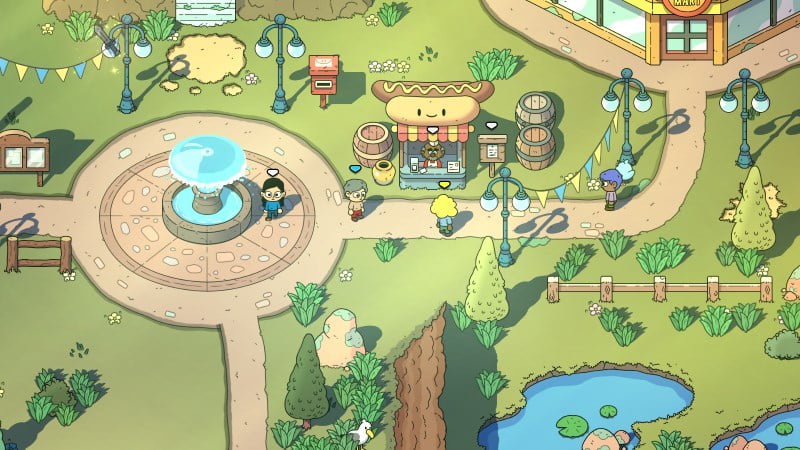
You wake on the beach. Greeted by a chirpy guiding spirit (who also happens to be a dung beetle) you are bidden by destiny to grab the titular sword, become the hero, and stop the evil witch before she enslaves the world for a hundred years. You gear up, the townsfolk bid you well, and you cut a path to the witch’s lair. And she straight-up murders you. This is a fight you were never destined to win; the failure is required to feed into the game’s roguelite loop proper.
A hundred years pass, under the witch’s rule. You wake up in a new, randomly generated body, in a house near town. Puku, the dung beetle spirit, tells you that you’ve been selected by fate to become The Sword of Ditto, and you must go and retrieve the sword from the grave of your predecessor. When you hold the sword aloft, the power transfers into you, and you have four days to build up your character before facing the witch, Mormo, again.
Everything is less well in Ditto than it was before. The days are cooler, and the nights a little darker. The buildings are showing signs of disrepair. Monsters roam the countryside, bolder, and in greater numbers, while the townsfolk are downbeat and afraid. The water is murky and a purple haze hangs in the air, colouring the once-cheery world in Mormo’s image.
That’s not to say that The Swords of Ditto is any less adorable for its plight. This is a remarkably pretty game, bristling with vigour and charm and a sense of bubblegum fun at all times. Cute birds scatter when you run amongst them; errant penguin explorers need catching and returning to their boss; the hero wields a Nerf gun and a golf club as well as the classic sword and bow; a frog and a giant octopus both want to trade collectable stickers (which act as buffs when you stick them on yourself). Even the game’s fast travel system – typically a dull collection of menu options – is a kazoo-powered, inter-dimensional flying bus, that leaves Back to the Future scorch marks on the ground.
But the worse you perform in your cyclical quest to rid the world of Mormo, the more grim the situation becomes.
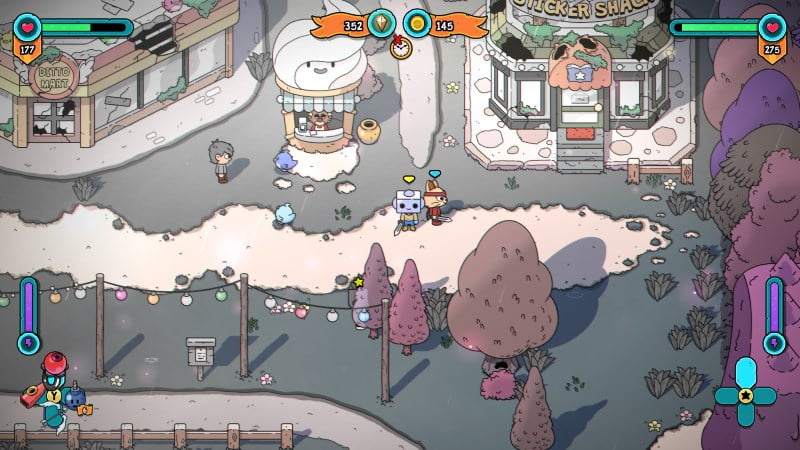
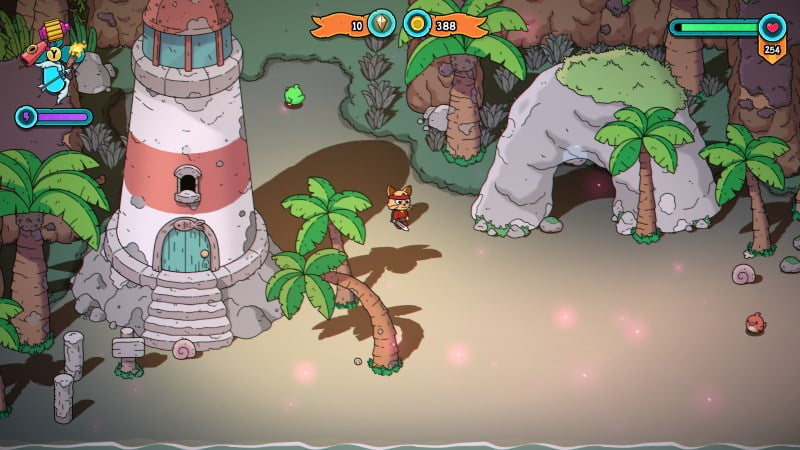

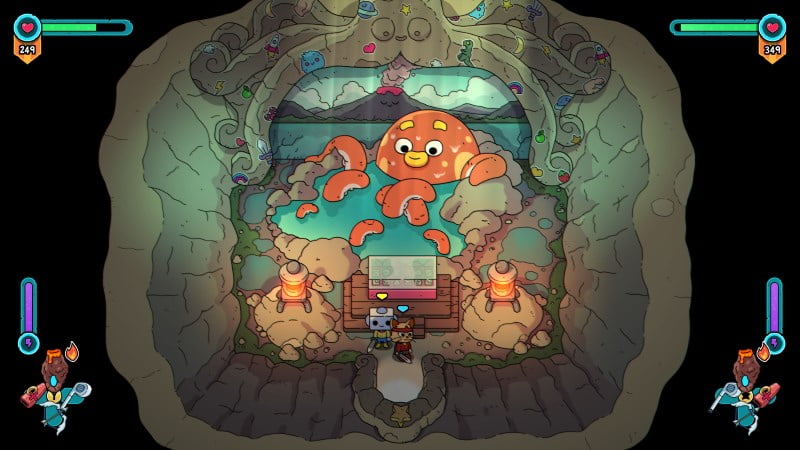
After several failed attempts – and believe me, you will fail – the world is in a sorry state, and the townsfolk aren’t afraid to let you know how they feel about it. Dying in an assault on Mormo’s tower feels worthwhile, at least, but dying out in the world, before even getting to the bottom of a four-day cycle? It’s ignominious.
Luckily, you can rope in a friend – or in my case, a wife (who’s never played Rogue or really anything like it before) – to provide backup in a drop-in/drop-out local co-op mode. In another cute nod back to gaming’s past, before the ubiquity of online play, The Swords of Ditto can be played by two people on one keyboard. This is a game that really understands its retro roots and gets the feeling just right.
That’s not to say that having a second player makes The Swords of Ditto any easier. The challenges and enemies scale with your character’s level, so you can never become overpowered, and enemy numbers increase with a second player. But having a buddy at least acts as a buffer. If you die solo, that’s basically it (though you may be able to strike a bargain with the goddess of time, a giant space whale) but a second player can resurrect you by sharing their health and literally hugging you back to life. Did we mention that The Swords of Ditto is flipping adorable?
There are also a few Zelda-inspired dungeon puzzles where a second player makes it easier. In some cases, we’ve found puzzles where it might have been very difficult without a buddy; luckily even a solo player could tag in a second character, manoeuvre them onto a switch plate (or whatever you need to progress) and then drop them back out when the puzzle is solved.
We have also run into a couple of puzzles that broke and were, effectively, unsolvable. The procedural nature of The Swords of Ditto – which changes everything from the player character to the world map to the dungeons in between runs – means that you’ll often run into the same puzzle in a different guise. Pick up gem/put on plinth/open door is a recurring motif. If a monster knocks said gem out of your hand and it falls into a pit, however, the gem should reset when you leave and re-enter the room, or failing that, the whole dungeon. Sometimes it doesn’t.
The consequence of this is you can’t complete one of the preliminary dungeons, meaning you can’t collect the best gear and weaken Mormo’s grip on the world, and can’t free the people from her tyranny for another 100 years. The Swords of Ditto can be frustrating, at times.
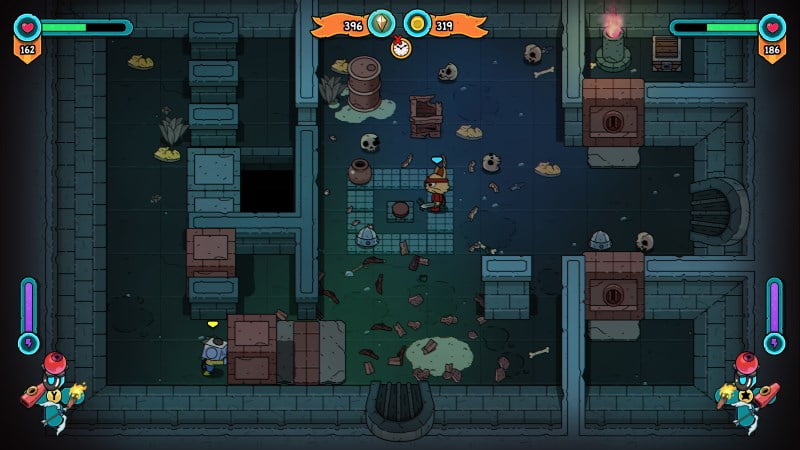


Ultimately, for all of its adorable presentation and sense of fun (that will absolutely work to broaden its appeal) The Swords of Ditto is still a procedural roguelite. Whether you love it or not will depend on how down you are with that particular revolving door mechanic.
To illustrate the point, here’s a rough transcript of the conversation between my wife and I, upon finally completing the game for the first time – as a purring cat and a robot whose head flashes as you move – on maybe our seventh or eighth run.
Mrs B: Finally! We did it!
Me: Just wait.
Mrs B: But it’s over! We killed Mormo! We saved the world! The dung beetle and the space whale are happy!
Me: Just… just give it a minute.
Mrs B: But we won! Everything is right with the world and why the hell are we waking up in our bed again? What is… what is the dung beetle doing here?
Me: You know how it loops around every 100 years, so if you die, you come back as a new player and get to have another go?
Mrs B: Yes…
Me: Well, that happens if you win, too. Mormo goes in 100-year cycles, win or lose.
Mrs B: So it’s basically… it’s a never-ending game?
Me: Basically.
Mrs B: Well I’m not going through all that again! We saved the world and everybody’s happy! My cat has a heroic statue rather than a morbid grave! Let’s just shut the game down and leave it there, forever, on a happy ending?
So we did.

Game: The Swords of Ditto
Platform: PlayStation 4, PC
Developer: One Bit Beyond
Publisher: Devolver Digital
Release Date: Out Now






